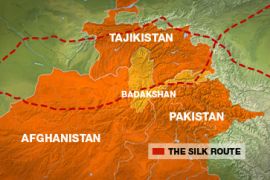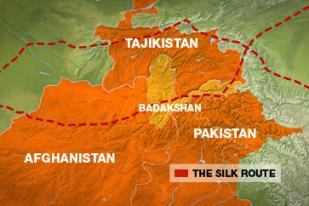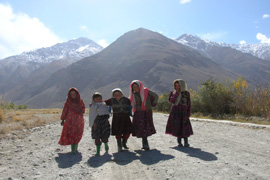Fallout of the Great Game
The Wakhan Corridor along the Silk Route was the result of wrangling between empires.

The Wakhan Corridor in Afghanistan’s Badakshan province is located in the Pamir mountain region, with Tajikistan to the north, Pakistan to the south and China to the east.
It is a slender finger of territory (in some places less than 20km wide) jutting east as a land corridor bordering the Oxus river or Amu Darya.
 |
| The Silk Route through the narrow Wakhan Corridor |
The borders of the Wakhan were set in an 1895 treaty between Russia and Britain, which had been wrestling over the control of Central Asia for nearly a century in what was dubbed the “Great Game”.
Keep reading
list of 4 itemsRussia’s Putin eyes greater support from China for Ukraine war effort
India-Iran port deal: A gateway to Central Asia or a geostrategic headache?
India’s income inequality widens, should wealth be redistributed?
Eventually the two agreed to use the entire Afghanistan as a buffer zone, with the Wakhan extension ensuring that the borders of the Russian empire would never touch the borders of British India.
Before being sucked into the Great Game, it formed part of the ancient silk route. It buzzed with trade and travellers, of whom the most famous, Marco Polo (1254-1324) left behind his legacy in the form of an exotic species of sheep that has been named after him.
Hsuan Tsang (602-664), the Chinese monk, also travelled the road as did British explorers looking for the source of the Oxus. Even today most of Wakhan has to be traversed on foot, or by using mules, donkeys, camels or yaks.
The remoteness of the Badakshan province is both a curse and a blessing.
While remote and virtually isolated from the rest of Afghanistan, it is one of the most astoundingly beautiful natural landscapes in the country on the edge of the “roof of the world”.
War and the difficulties of access have kept the area in a pristine form, its rugged charm still unbroken by tourist trappings. The area is inhabited by the agro-pastoral Wakhi in the lower region and the pastoral nomadic Kyrghyz in the higher reaches.
The corridor has a completely different socio-cultural milieu from most of Afghanistan as well as its own languages with their myriad dialects. Wakhi is the principle language spoken lower down while further up it is Kyrghyz.
Abundant bio-diversity
The area is also abundant in bio-diversity. Most of the Wakhan is high altitude valleys; none are below the altitude of 2500m. Three mountain ranges, the Karakoram, Pamir and Hindu Kush converge in the Wakhan.
 |
| Afghan girls on a road on the Marco Polo trail through the Hindu Kush [Mojumdar] |
The Hindu Kush ranges in the south have 38 peaks over 7000m including the highest peak in Afghanistan, the Noshaq (7492m).
The valleys between the three mountain ranges form the Bam-e-Duniya (roof of the world), the Afghan Pamir.
Along the sparkling Panj river, (the source of the Amu Darya), the landscape changes continuously. Steep mountain sides give way to rolling dunes while black stone gives way to grey sand and brown earth. The landscape is dominated by stones of many rich colours and amazing shapes.
Though the Marco Polo sheep is the most famous and sought after inhabitant, a 1977 wildlife survey showed the existence of snow leopards, the Himalayan lynx, brown bear and Siberian Ibex.
For mountaineers, peaks and areas which have not been climbed for the last 30 years are an exotic attraction.